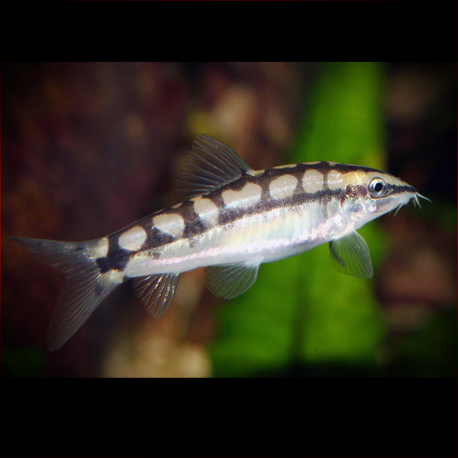More info
Datasheet
| Minimum Tank Size | 96 litres / 25.36 US gallons |
| Maximum Size | 6.0cm / 2.36inches |
| Temperature | 20°C / 68.00°F - 30°C / 86.00°F |
| Hardness | 1.01dgH / 18ppm - 12.05dgH / 215ppm |
| pH | 5.5-7.5 |
Behaviour
This species, known as the Dwarf Chain Loach, is often considered a suitable addition to community aquariums, although conflicting observations exist regarding its temperament. While some aquarists find it to be peaceful over time, others report instances of aggression, particularly towards sedentary or long-finned fish. Injuries in such cases may include missing eyes or chunks of finnage, with reasons for this behavior remaining unclear. Keeping these loaches in larger groups of at least 5-6 specimens, ideally 10 or more, is recommended to avoid dominance issues. They exhibit gregarious behavior and appear to establish complex social hierarchies. When kept singularly, they may become withdrawn or aggressive, especially towards similar-shaped fish. There are various reported behavioral rituals among Ambastaia spp., such as dominance battles and the 'greying out' phenomenon during such interactions.
Feeding and Diet
Being primarily carnivorous, Dwarf Chain Loaches also consume vegetative matter, especially soft-leaved aquatic plants. Their diet should include a variety of food such as quality dried products, live or frozen larvae, Daphnia, and fresh fruits/vegetables. They are bold feeders that rise into midwater during meals and can also be fed with homemade gelatin-bound foods. Although they may prey on aquatic snails, they are not strictly molluscivores, and excessive reliance on them for pest control is discouraged.
Reproduction & Dimorphism
A. sidthimunki is commercially farmed using hormones but reports of private breeding are rare, possibly due to their seasonal, migratory spawning behavior in the wild. While controlled breeding without chemical stimulation remains challenging, instances of breeding have been observed in established aquariums. Sexually mature females typically have a fuller body and grow slightly larger than males, who develop elongated snouts and fleshy, thickened lips.
Habitat and Distribution
Maintaining a structured aquarium setup is crucial for Dwarf Chain Loaches' well-being. They thrive in well-oxygenated water with some flow and require a clean environment, making weekly water changes essential. These loaches are best suited for stable, mature aquariums and should be housed in tanks with ample hiding spots like rocks, driftwood, and plants. Sharp-edged decorations should be avoided to prevent injuries, and a secure cover is necessary to prevent escape. In their natural habitat, they inhabit slow-flowing, forested sections of rivers with clear water and a mix of sand, rocks, and driftwood.
For detailed aquarium setup guidelines, refer to the table provided in the original information.

